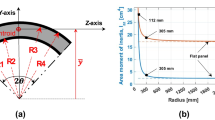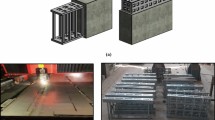Abstract
While the recent high demand for high rise buildings has led to the development of high-performance and high-strength steels, the requirements for structural-performance steel for such buildings have been raised as engineers recognized the potential wreak damage that an earthquake could cause on a tall building. Many studies on high-strength steels have explored such requirements, but appropriate design equations are needed for the case of hollow structural section (HSS) due to the design equations that limit the maximum yield stress up to 360MPa in the design codes (AISC, 2011; KBC, 2009). This study investigated the behavior of 600MPa plate-to-circular hollow section joints subjected to applied moment and shear force by experiment and finite element analysis (FEA), and the results are compared with current design equations. The nominal strength of AISC (2005) (or KBC (2009)) overestimated the tested strength in the range between 105% and 137%. It is found that the nominal strength equation of AISC (2011) is reasonably revised in comparison to those of other design codes.
Similar content being viewed by others
References
ABAQUS (1998a). ABAQUS/Standard User’s Manual. Version 5.8. Hibbitt, Karlsson & Sorensen, Inc., Rhode Island, USA.
ABAQUS (1998b). ABAQUS/Viewer User’s Manual. Version 0. Hibbitt, Karlsson & Sorensen, Inc., Rhode Island, USA.
ABAQUS (2000). ABAQUS/CAE User’s Manual. Version 6.1. Hibbitt, Karlsson & Sorensen, Inc., Rhode Island, USA.
AIJ (2002). Recommendation for the Design and Fabrication of Tubular Truss Structures in Steel. Architectural Institute of Japan, Japan (in Japanese).
AISC (2005). Steel Construction Manual. 13th Ed., American Institute of Steel Construction, USA.
AISC (2011). Steel Construction Manual. 14th Ed., American Institute of Steel Construction, USA.
Ariyoshi, M. and Makino, Y. (2000) “Load-deformation relationship for gusset-plate to CHS tube joints under compression loads.” International Journal of Offshore and Polar Engineering, 10(4), pp. 292–300.
Ariyoshi, M., Wilmshrtst, S. R., Makino, Y., van der Vegte, G. J., and Choo, Y. S. (1998). “Introduction to the database of gusset-plate to CHS tube joints.” Proc. 8th International Symposium on Tubular Structures, Singapore, Tubular Structures VIII, pp. 203–211.
KBC (2009). Korean Building Code and Commentary (KBC). Architectural Institute of Korea, Korea (in Korean).
Kim, J. R., Kim, S. S., Lee, C. H., Lee, E. T., and Beak, G. Y. (2008a). “A study on the material characteristics and the welding properties of 600MPa grade steel (SM 570 TMC).” Journal of Korean Society of Steel Construction, 20(6), pp. 773–781 (in Korean).
Kim, J. R., Oh, Y. S., Beak, G. Y., and Chang, S. Y. (2008b). “A study on elasto-plastic behavior of column-to-beam welded connection with 600MPa class high performance steel.” Journal of Korean Society of Steel Construction, 20(6), pp. 783–792 (in Korean).
Lee, M. M. K. and Wilmshurst, S. R. (1995). “Numerical modelling of CHS joints with multiplanar double-K configuration.” Journal of Constructional Steel Research, 32(3), pp. 281–301.
Lee, S. H., Shin, K. J., Lee, H. D., and Kim, W. B. (2012a). “Test and analysis on the longitudinal gusset plate connection to circular hollow section (CHS) of high strength.” Journal of Korean Society of Steel Construction, 24(1), pp. 35–46 (in Korean).
Lee, S. H., Shin, K. J., Lee, H. D., and Kim, W. B. (2012b). “Test and analysis on the transverse gusset plate connection to circular hollow section (CHS) of high strength.” Journal of Korean Society of Steel Construction, 24(2), pp. 163–173 (in Korean).
Lu, L. H., Puthli, R. S., and Wardenier, J. (1993). “Semirigid connections between plates and rectangular hollow section columns.” Proc. 5th International Symposium on Tubular Structures, Tubular Structures V, pp. 723–740.
Lu, L. H., de Winkel, G. D., Yu, Y., and Wardenier, J. (1994). “Deformation limit for the ultimate strength of hollow section joints.” Proc. 6th International Symposium on Tubular Structures, Australia, Tubular Structures VI, pp. 341–347.
Packer, J. A. and Henderson, J. E. (1992). Design Guide for Hollow Structural Section Connections. Canadian Institute of Steel Construction, Canada.
Packer, J. A, Sherman, D., and Lecce, M. (2010). Steel Design Guide 24 — Hollow Structural Section Connections. American Institute of Steel Construction, USA.
RIST (2010). Development of Solution Technology for Mega Structural Steel. Research Institute of Industrial Science & Technology, Ministry of Knowledge Economy, Korea (in Korean).
Seay, P. A. (1998). Finite Element Analysis of Geotextile Tubes. M.S. thesis, Virginia Polytechnic Institute and State University, Blacksburg, VA.
Voth, A. P. (2010). Branch Plate-to-Circular Hollow Structural Section Connections. Ph.D. thesis, University of Toronto, Ontario, Canada.
Wardenier, J. (1982). Hollow Section Joints. Delft University Press, Netherlands.
Wardenier, J. (2001). Hollow Sections in Structural Applications. Comité International pour le Développement et l’Étude de la Construction Tubulaire/Verlag LSS (CIDECT), http://www.cidect.com/en/Publications.
Wardenier, J., Kurobane, Y., Packer, J. A., Vegte, G. J. van der, and Zhao, X. L. (2008). Design Guide for Circular Hollow Section (CHS) Joints under Predominantly Static Loading. 2 nd edition, Comité International pour le Développement et l’Étude de la Construction Tubulaire/ Verlag LSS (CIDECT), http://www.cidect.com/en/ Publications.
Winkel, G. D. de, Rink, H. D., Puthli, R. S., and Wardenier, J. (1993). “The behaviour and static strength of plate to circular column connections under multiplanar axial loadings.” Proc.5 th International Symposium on Tubular Structures, Tubular Structures V, pp. 703–71
Yura, J. A., Zettlemoyer, N., and Edwards, I. F. (1980). “Ultimate capacity equations for tubular joints.” Proc. Offshore Technology Conference, Houston, USA, 1, pp. 113–126.
Yura, J. A., Zettlemoyer, N., and Edwards, I. F. (1981). “Ultimate capacity of circular tubular joints.” Journal of the Structural Division, ASCE, 107(10), pp. 1965–1984.
Author information
Authors and Affiliations
Corresponding author
Additional information
Note.-Discussion open until May 1, 2013. This manuscript for this paper was submitted for review and possible publication on May 8, 2012; approved on October 2, 2012.
Rights and permissions
About this article
Cite this article
Lee, SH., Shin, KJ., Lee, HD. et al. Behavior of plate-to-circular hollow section joints of 600 MPa high-strength steel. Int J Steel Struct 12, 473–482 (2012). https://doi.org/10.1007/s13296-012-4002-6
Published:
Issue Date:
DOI: https://doi.org/10.1007/s13296-012-4002-6




